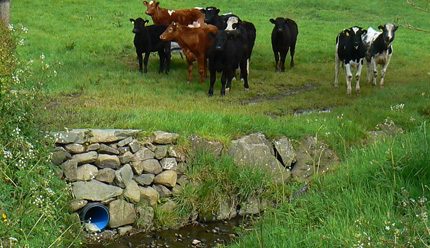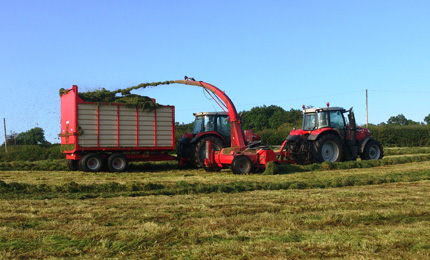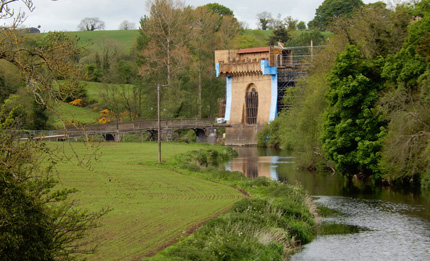Soil Science Society of America
5585 Guilford Road • Madison, WI 53711-5801 • 608-273-8080 • Fax 608-273-2021
www.soils.org
Twitter | Facebook
NEWS RELEASE
Contact: Hanna Jeske, Associate Director of Marketing and Brand Strategy, 608-268-3972, hjeske@sciencesocieties.org
Tidy farms, healthy streams
Oct. 5, 2016 - In 1990, many streams in Northern Ireland were so polluted they couldn’t sustain fish. “Farmers said they were worried about their cows drinking from them,” says water scientist Chris Barry.
 But cows were part of the problem. The impacted streams drain a grassland region that hosts mostly cattle farms. Streams feed into larger rivers, and for much of Northern Ireland these drain into two large lakes, Loughs Neagh and Erne, which are major drinking water sources.
But cows were part of the problem. The impacted streams drain a grassland region that hosts mostly cattle farms. Streams feed into larger rivers, and for much of Northern Ireland these drain into two large lakes, Loughs Neagh and Erne, which are major drinking water sources.
The health of upriver streams, or headwaters, is vital to the function and biodiversity of downstream waters. By 1990, farm pollution had damaged over half of these small tributaries.
Over the next two decades, the government enacted broad reforms to lower the amount of pollution leaking into streams. Scientists from the Agri-Food and Biosciences Institute, where Barry worked, monitored the impact regional reforms had on stream health.
Starting in 1990, the team regularly sampled 40 streams split between two river basins. Researchers found two main problems. The first was excess nutrients. Both phosphorus and nitrogen were disrupting the ecological balance in streams. While nutrients occur naturally in the soil, in abundance they encourage algae growth. This chokes the streams and deprives trout and other aquatic life of enough oxygen to survive.
The second, and most obvious, problem was discharges of organic wastes from farmyards. This directly removes oxygen from the water and results in toxic concentrations of ammonium and other nutrients.
 Here the biggest culprit was the discharge of silage effluent. Farmers in Northern Ireland use silage made from fermented grass as a cattle feed, particularly in winter. The effluent is rich in organic acids and nutrients and can be devastating to streams. This is especially true in summer when river flows offer little dilution. Changes in the silage making process encocuraged wilting of the grass after it is cut, which reduced the amount of liquid leaching out.
Here the biggest culprit was the discharge of silage effluent. Farmers in Northern Ireland use silage made from fermented grass as a cattle feed, particularly in winter. The effluent is rich in organic acids and nutrients and can be devastating to streams. This is especially true in summer when river flows offer little dilution. Changes in the silage making process encocuraged wilting of the grass after it is cut, which reduced the amount of liquid leaching out.
Tracking these scattered sources of pollution from farms can be tricky. It can trickle from leaky silage containers or percolate into them from farmyards. “It’s difficult to pull apart the data to identify a single source of pollution,” says Barry.
The reforms put in place by the government targeted both farmyard effluents and nutrients in runoff from fields. They included grants for better silage and manure storage facilities, and limits on fertilizer use. In 2005, a European Union policy denied farm subsidies to farmers who didn’t comply with environmental standards.
“On one level they were tidying up the farms, but farmers have also been making better use of nutrients from livestock manures,” says Barry.
Farm productivity in Northern Ireland has held up despite large reductions in the use of chemical fertilizers. Phosphorus sales, for example, are down by 79% and nitrogen by 37%.
 Two decades of interventions have had positive impacts on streams. But these have been gradual and at times uneven. Pollution caused by organic wastes from farmyard effluents was substantially reduced by the late 1990s and was almost absent 10 years later. Nitrate concentrations have been in a long-term decline throughout the monitored streams.
Two decades of interventions have had positive impacts on streams. But these have been gradual and at times uneven. Pollution caused by organic wastes from farmyard effluents was substantially reduced by the late 1990s and was almost absent 10 years later. Nitrate concentrations have been in a long-term decline throughout the monitored streams.
In contrast, phosphorus only began to decline appreciably after 1998, but by 2008 reductions were widespread. This was most apparent in the streams draining land of moderate farming intensity used for beef production. It was less obvious in areas dominated by dairy farming. There remains a very strong relationship between livestock density and nutrient concentrations in these streams.
Despite this lingering impact of farming on water quality, Barry says he hopes the study will demonstrate the positive impacts of agricultural stewardship. “Targeting all of the sources and how they are transferred to streams is paramount to bringing about long-term positive improvements,” says Barry.
In the future, Barry's colleagues hope to use new technology to understand more precisely how and when pollutants reach streams. They also want to map areas where storm events are likely to cause problems for water pollution. This may help farmers make better use of nutrients applied to land as fertilizers and livestock manures.
Read more about Barry’s research in Journal of Environmental Quality. The research was funded by the Department of Agriculture, Environment and Rural Affairs (DAERA) Northern Ireland, with support from the Environmental Protection Agency (EPA, Republic of Ireland) under the Science, Technology, Research and Innovation for the Environment (STRIVE) Program 2007-2013.
Journal of Environmental Quality publishes original research, reviews and analyses, and environmental issue articles that address anthropogenic impacts on water, soil, and the atmosphere and pertain to some aspect of environmental quality in natural and agricultural ecosystems.